Guide-Tested Winter Jigging Tips: Perch and Walleyes
Joel Nelson 02.26.18

Fact: Not all fish bite, especially during mid-winter, and you must focus on the next fish that appears on your electronics and hopefully learn from the last one. So, how do you attract the next one and actually close the deal?
Your jigging stroke has the power to attract fish from distance and entrap them in a trance-like state, as they hang on your every movement until they have no choice but to commit. Your cadence, unfortunately, also has the tendency to draw them in close, only to get a strong snub upon a very close and tense inspection.
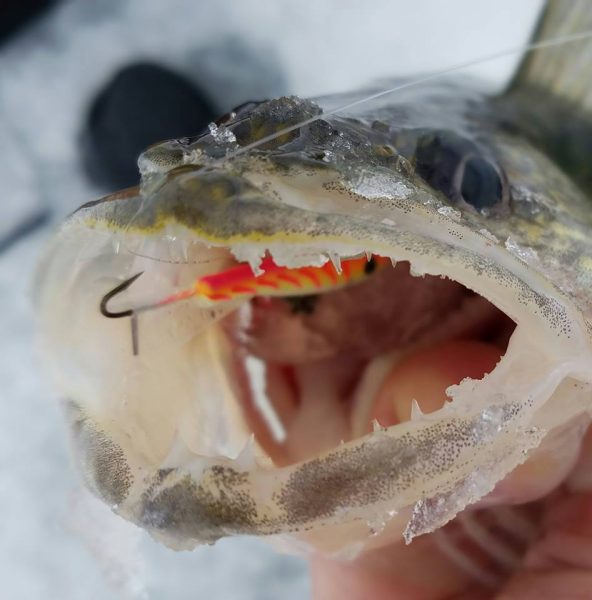
You want to know the secret to unlocking the bite? What does it take to convert those lookers to biters?
Unfortunately, I don’t know. Really, I can’t predict what it is that an individual fish will like, on a specific weather pattern, on lakes with differing structure, predator/prey relationships, and oxygenation. The good news, however, is each trip on the ice is a different occasion for hope and ultimately, testing.
While I can’t offer a simple strategy for always knocking them dead, I can tell you my approach and process of elimination that has served me well through the years. I can also share some common issues with the way most people jig, hopefully helping you to eventually crack the code of the day, every time you hit the ice. For the sake of ease, I’ll cover walleyes and perch in this article, and save sunfish and crappies for a follow-up story.
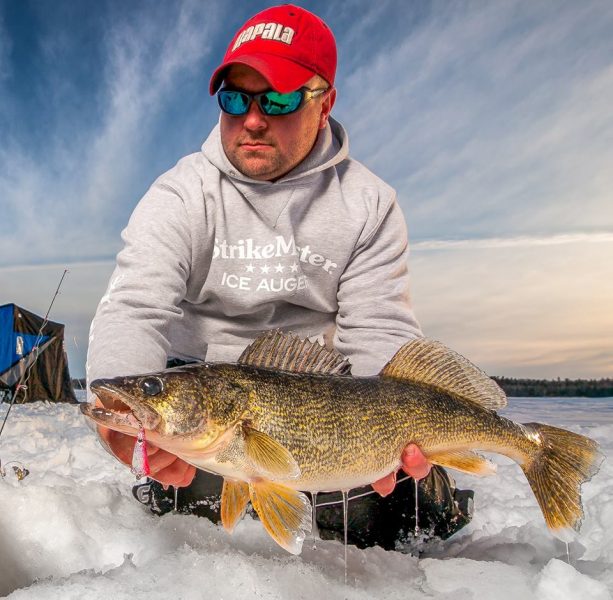
Walleyes
The first thing to remember with ‘eyes is they’re predators, so I start aggressive. “Take their temperature” by starting with larger and quicker jigging motions. Most importantly, jig 2-5 feet off bottom to give them room to appear under your bait. Jig too close to the floor, and bottom-hugging fish can approach only from the sides, giving you precious little real estate on your flasher to observe them.
After the first few fish, you should have a good idea regarding their aggressiveness. Are they spooking when you drop the bait in their face, or do they chase it to bottom, hovering over it while it lays in the mud? Similarly, will they follow the bait upward, several feet off the bottom where they originated? Aggressive approaches for fish that are willing will yield the most efficient results, but we know that mid-winter fish are famously stingy. This is where you really break down the bite.
Sharp jigging motions now should only be used to draw fish underneath your bait and into the cone of your sonar. Once detected, every fish needs far more subtle motions. Focus on naturally wiggling the bait, first with small continuous spring-like jigging motions, as if you were drawing a small oval with your rod tip the size of a marble. Most fish are over-jigged at this stage, so that marble-sized stroke should be a good indicator if you’re waving the wand a bit too heavily.
From there, experiment with changing a few variables. First, the size of your jigging stroke; go from drawing a marble, to maybe something the size of a golf ball or bigger, then maybe back to something even smaller yet, that you can only achieve not by jigging, but by simply squeezing the cork on your rod handle. Next, experiment with working that entire motion upward in the water column. Will the fish chase? Do they react only when the bait is moving, or do they like it when you occasionally “kill” the bait?
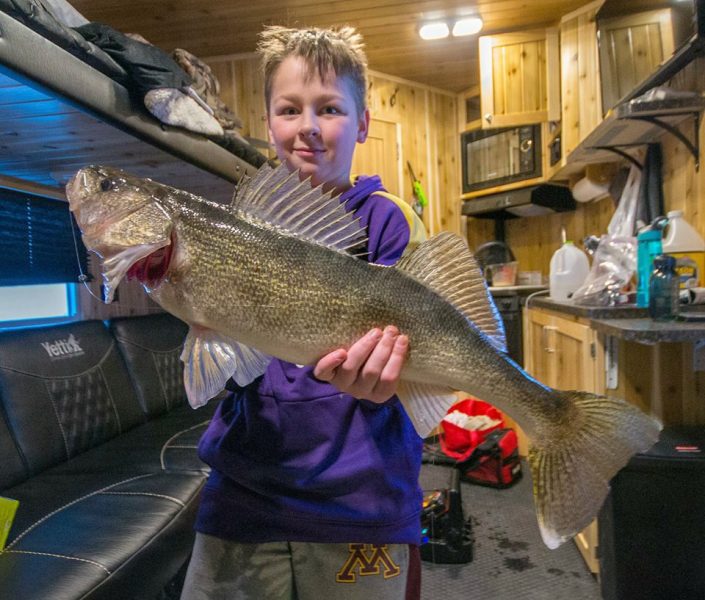
Tough customers sometimes require the above and more, as you tease them off bottom, watch them retreat, then approach all over again several times. This is where it’s best to keep doing what you’re doing on a per-fish basis. In other words, don’t experiment with too many different jigging strokes for a single fish. Instead, let the fish leave, reset your approach, then feed a new fish a new look.
Study an underwater camera and learn what small taps on a rod blank with your forefinger can mean for the bait and how it jumps. Recreate what is successful, reject what is not, treating each fish like the individual it is, while looking for clues and general patterns for all the fish you work. Of course, a target-rich environment is best for learning, and experience is usually the best teacher, especially when fish aren’t abundant.
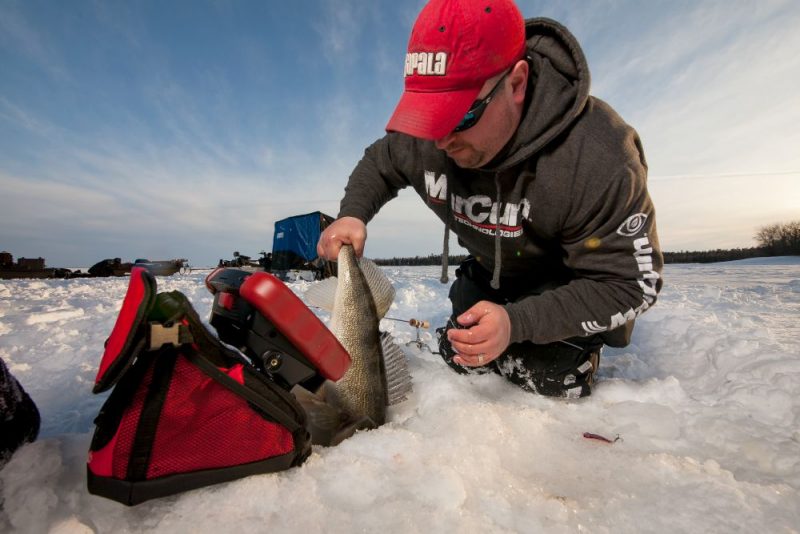
Perch
Perch are typically aggressive school feeders that eat in a flurry. Commotion is what they thrive upon, often even when they’re in a neutral mood. Active schools move about constantly, requiring as much drilling as they do dropping of jigs, but keeping their attention is of paramount importance. This is often best done with some friends, with one person continually jigging aggressively while marking fish, and another experimenting with different baits and jigging styles around the edges. After the sonar marks disappear, it’s on the drill again to hunt them down.
I break down the bite according to what they’re eating: free-ranging invertebrates about the water column, or bottom-focused meals that emerge from the substrate. Bloodworm or bottom-hugging invertebrate bites are all about being near the lake bottom, putting the bait in the mud as much as above it, and potentially even using underwater cameras for bite detection.
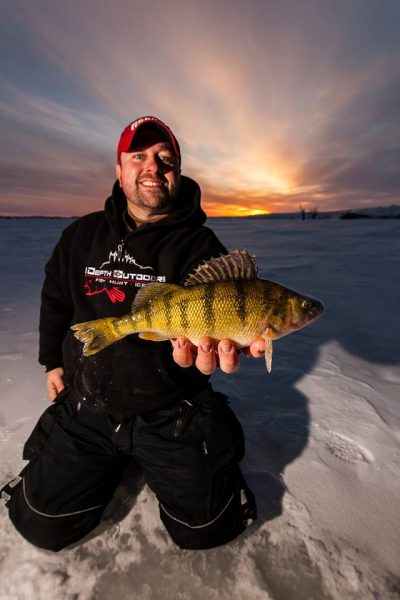
I remember several extremely tough Devil’s Lake (North Dakota) bites where fresh minnows and jigs layed on bottom were the only way to get bit. The struggling minnow was slurped up from bottom, but never while hanging anywhere in the water column. Jig down into the mud, with a tight line, stirring up mud and debris until you’ve created a visible cloud on your underwater camera. Study how fish react, learning how much to stir it up, and how much to wait it out.
Other bites above bottom, like that of an underwater insect hatch from mayflies or caddis, will often see caught perch spitting up these invertebrates around the hole as you pull them out. These bites call for aggressive jigging upward in the water column, as you work fish higher and higher to get them revved up. Playing keep-away here can be vitally important, as I believe the school gets more active with more fish feeding about different depth ranges. Fire them up, and only then focus on catching them.
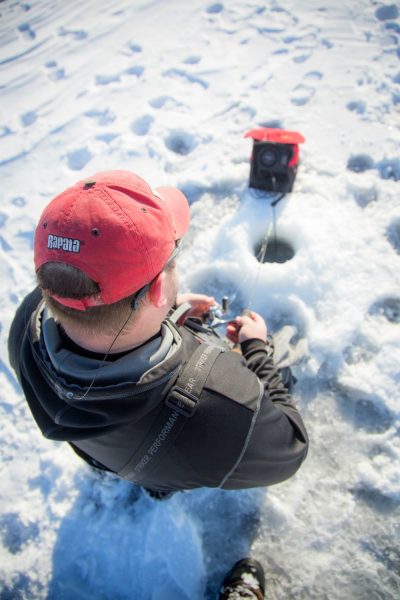
There’s no one-way to skin a walleye or a perch, but these starting points are a good way to launch the every-trip experiment, while honing observational skills on your way to cracking the day’s bite.
Editor’s note: Be sure to stay tuned to OutdoorHub for part two of this story where Joel Nelson provides insights and jigging tips for sunfish and crappies.

